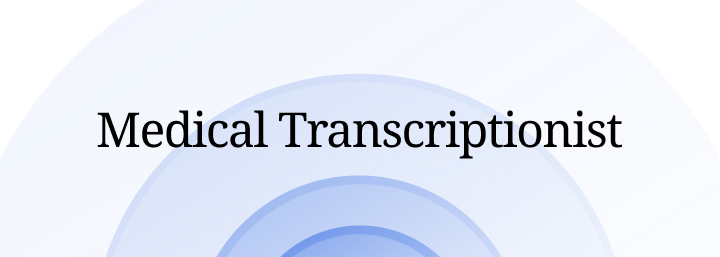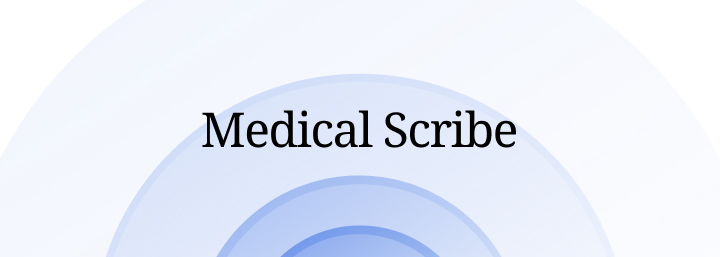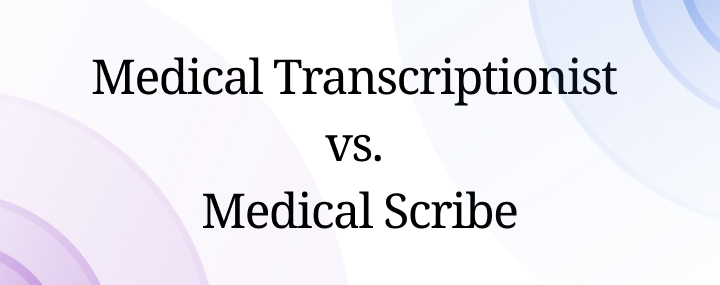Is A Medical Transcriptionist The Same As A Scribe?
Table of Contents
Imagine you are a busy physician who has to see dozens of patients every day. You know how important it is to document every detail of your patient encounters, but you also know how time-consuming and tedious it can be. You wish you had someone who could help you with your documentation and administrative tasks so that you could focus more on your patient care and less on your paperwork.
You might have heard of the terms medical transcriptionist and medical scribe. These two types of professionals can assist you with your documentation needs. But what exactly are the differences between them? And which one should you choose for your practice?
This blog post will explore the definitions, roles, skills, benefits, and challenges of medical transcriptionists and scribes. We will also compare and contrast workflow, training, and salary. By the end of this post, you will better understand these two professions and how they can help you improve your efficiency and patient care.
Medical Transcriptionist: Definition and Role

A medical transcriptionist is someone who converts a physician’s voice dictation into a written document. They use their skills to listen to audio files and accurately type out the medical information that the physician has recorded. They also edit and format the document according to the standards and protocols of the healthcare facility.
Understanding the Responsibilities of a Medical Transcriptionist
A medical transcriptionist's main responsibility is to create accurate and complete medical records based on the physician's dictation. They may transcribe various documents, such as patient histories, physical examinations, diagnoses, treatment plans, prescriptions, discharge summaries, and referral letters.
A medical transcriptionist may also perform other tasks, such as:
Reviewing and verifying the accuracy and completeness of the transcribed document
Identifying and correcting any errors or inconsistencies in the document
Ensuring that the document follows the appropriate grammar, spelling, punctuation, and medical terminology
Adhering to the confidentiality and security policies of the healthcare facility
Communicating with the physician or other healthcare professionals if there are any questions or clarifications regarding the dictation
Skills and Qualifications Required for Medical Transcriptionists
To become a medical transcriptionist, one needs to have certain skills and qualifications, such as:
High school diploma or equivalent
Certificate or associate degree in medical transcription from an accredited program
Good command of the language and grammar
Fast and accurate typing speed (at least 60 words per minute)
Proficient knowledge of medical terminology, anatomy, physiology, pharmacology, and abbreviations
Familiarity with various dictation systems and software applications
Attention to detail and a high level of accuracy
Good listening and comprehension ability
Strong work ethic and a sense of responsibility
The Benefits and Challenges of Being a Medical Transcriptionist
Being a medical transcriptionist can have some benefits and challenges, such as:
Benefits
Flexible work schedule: Many medical transcriptionists work from home or remotely, which allows them to set their hours and pace.
Variety of work opportunities: Medical transcriptionists can work for different healthcare facilities, such as hospitals, clinics, laboratories, insurance companies, or legal firms.
Rewarding career: Medical transcriptionists play an important role in ensuring the quality and accuracy of medical records, which can affect the diagnosis and treatment of patients.
Challenges
High-pressure work environment: Medical transcriptionists have to deal with tight deadlines, heavy workloads, and complex dictations. They also have to cope with poor audio quality, background noise, or accents that may affect their transcription.
The constant need for updating skills: Medical transcriptionists must keep up with the changes in medical terminology, technology, regulations, and standards. They also have to undergo regular training and certification to maintain their competency.
Risk of physical and mental strain: Medical transcriptionists may experience physical problems such as eye strain, neck pain, back pain, or carpal tunnel syndrome due to prolonged sitting and typing. They may also experience mental stress due to the nature of their work.
Medical Scribe: An Overview

A medical scribe accompanies a physician during patient visits and documents the relevant medical information in real-time. They use their skills to capture and enter the data into the EHR system while the physician focuses on the patient's care.
The Role and Responsibilities of a Medical Scribe
A medical scribe's main role is to assist the physician with documentation and administrative tasks. They may perform various duties, such as:
Recording the patient’s chief complaint, history of present illness, past medical history, family history, social history, review of systems, physical examination findings, diagnostic tests ordered or performed, diagnoses, treatment plans, prescriptions, and follow-up instructions
Updating the patient’s problem list, medication list, allergy list, and immunization record
Retrieving the patient’s lab results, radiology reports, consultation notes, or other relevant information
Preparing the patient’s chart for the physician’s review and signature
Facilitating the communication and coordination between the physician and other healthcare professionals, such as nurses, pharmacists, specialists, or referrals
Ensuring the compliance and accuracy of the documentation according to the EHR system and the healthcare facility’s policies
Essential Skills and Qualifications for Medical Scribes
To become a medical scribe, one needs to have certain skills and qualifications, such as:
High school diploma or equivalent
Certificate or training program in medical scribing from an accredited organization
Good command of the language and grammar
Proficient knowledge of medical terminology, anatomy, physiology, pharmacology, and abbreviations
Familiarity with various EHR systems and software applications
Attention to detail and a high level of accuracy
Good listening and comprehension ability
Strong work ethic and a sense of responsibility
Strong interpersonal communication skills
The Benefits and Challenges of Being a Medical Scribe
Being a medical scribe can have some benefits and challenges, such as:
Benefits
Valuable learning experience: Medical scribes can gain first-hand exposure to the clinical setting and learn from the physician's expertise. They can also enhance their medical knowledge and skills by observing patient cases.
Potential career advancement: Medical scribes can use their experience as a stepping stone to pursue further education or employment in the healthcare field. They can also build their network and connections with other healthcare professionals.
Satisfying career: Medical scribes can contribute to the improvement of patient care and satisfaction by reducing the physician’s workload and increasing their efficiency.
Challenges
A demanding work environment: Medical scribes have to work in a fast-paced and dynamic setting, where they have to multitask and adapt to different situations. They also have to deal with various challenges, such as technical issues, interruptions, distractions, or emergencies.
A high level of responsibility: Medical scribes must follow the physician's instructions and document the information accurately and completely. They also have to adhere to the confidentiality and security policies of the healthcare facility.
A risk of physical and mental strain: Medical scribes may experience physical problems such as fatigue, dehydration, or infection due to long hours of standing and working. They may also experience mental stress due to the nature of their work.
How are Medical Transcriptionists and Scribes Different?

Medical transcriptionists and medical scribes are both involved in creating medical records based on the physician's dictation. However, they have significant differences in their workflow, training, and salary.
Differences in Workflow and Documentation Practices
The main difference between medical transcriptionists and scribes is how they obtain and document the medical information. The following table summarizes their workflow and documentation practices:
| Aspect | Medical Transcriptionist | Medical Scribe |
|---|---|---|
Location Timing | Works remotely or in a separate office Works asynchronously after the patient visit | Works synchronously during the patient visit Works synchronously during the patient visit |
Source Method | Receives audio files from the physician Types out the dictation verbatim | Listens directly to the physician and patient Enters the data into the EHR system |
Format | Creates a written document | Updates an electronic record |
Variances in Training and Certification Requirements
Another difference between medical transcriptionists and scribes is their training and certification requirements. The following table compares their education and credentialing options:
| Aspect | Medical Transcriptionist | Medical Scribe |
|---|---|---|
Education Certification | Completes a certificate or associate degree program in medical transcription (6 months to 2 years) Obtains a voluntary certification from the Association for Healthcare Documentation Integrity (AHDI), such as Registered Healthcare Documentation Specialist (RHDS) or Certified Healthcare Documentation Specialist (CHDS) | Completes a certificate or training program in medical scribing (3 months to 1 year) Obtains a voluntary certification from organizations such as the American College of Medical Scribe Specialists (ACMSS), American Healthcare Documentation Professionals Group (AHDPG), or ScribeAmerica |
Comparing Salary for Medical Transcriptionists and Scribes
A third difference between medical transcriptionists and medical scribes is their salary. The following table shows their average annual salary:
| Aspect | Medical Transcriptionist | Medical Scribe |
|---|---|---|
Salary per year (2021) |
Choosing Between a Medical Transcriptionist and a Scribe for Your Practice
As you can see, medical transcriptionists and medical scribes have different roles, skills, benefits, and challenges. Depending on your practice's needs and preferences, you may hire one or the other, or both. However, there is another option to consider: using an AI medical transcriptionist or scribe.
The Pros and Cons of Hiring a Human vs. an AI Medical Transcriptionist or Scribe
An AI medical transcriptionist or scribe is a software application that uses artificial intelligence to transcribe and document the physician's dictation. Unlike a human medical transcriptionist or scribe, an AI medical transcriptionist or scribe does not require training, certification, or supervision. It can also work faster, cheaper, and more accurately than a human counterpart.
However, an AI medical transcriptionist or scribe has some limitations and drawbacks. For example, it may not be able to handle complex or ambiguous dictations, recognize different accents or dialects, or capture the nuances and emotions of the physician's speech. It may also encounter technical glitches, security breaches, or ethical issues that may compromise the quality and integrity of the documentation.
The following table summarizes the pros and cons of hiring a human vs. an AI medical transcriptionist or scribe:
| Aspect | Human | AI |
|---|---|---|
Pros Cons | - Can provide personalized and customized service - Can handle various situations and scenarios - Can add value and insight to the documentation - May require training, certification, and supervision - May have higher costs and errors - May experience physical and mental strain | - Can work faster and more efficiently - Can reduce costs and errors - Can improve productivity and quality - May not be able to handle complex or ambiguous dictations - May not be able to recognize different accents or dialects - May encounter technical glitches, security breaches, or ethical issues |
Conclusion
Medical transcriptionists and scribes are two types of professionals who can help you with documentation tasks. They have different roles, skills, benefits, and challenges that you need to consider before hiring them. Alternatively, you can also opt for an AI medical scribe that can offer you some advantages over a human counterpart.
However, not all AI medical scribes are created equal. You need to find one that can meet your needs and expectations. We recommend Tali, an AI medical dictation and ambient scribe tool that can greatly assist you with your documentation needs.
Tali is designed to be easy to use, reliable, and secure. You can simply use your voice to dictate your notes, and Tali will transcribe them into text and enter them into your EHR system. Tali has some features that make it stand out from other AI medical scribes, such as:
Work with any EHR system and integrate seamlessly with your workflow.
Understand natural language and context and generate accurate and complete documentation.
Comply with the HIPAA and other regulations and ensure the confidentiality and security of your data.
Experience the benefits of Tali with our free trial. Sign up today and see how Tali can make your documentation easier, faster, and better.
FAQ
While medical transcriptionists and scribes assist with documentation tasks, their primary difference lies in their workflow and responsibilities. A medical transcriptionist listens to audio files of physician dictations and converts them into written documents, focusing on accuracy and proper formatting. On the other hand, a medical scribe accompanies the physician during patient visits, recording real-time medical information directly into the electronic health record (EHR) system. The scribe's role involves capturing patient history, physical examination findings, diagnoses, treatment plans, and more during the visit.
Both professions require a strong command of language and grammar, as well as proficiency in medical terminology, anatomy, and physiology. A high school diploma or equivalent is necessary for medical transcriptionists, and a certificate or associate degree in medical transcription. They also need fast and accurate typing skills, familiarity with medical software, and attention to detail. Medical scribes, too, need a high school diploma or equivalent, but they undergo training in medical scribing from accredited organizations. They also require good listening and comprehension abilities, familiarity with EHR systems, and strong interpersonal communication skills due to their direct interaction with healthcare professionals and patients.
AI medical transcriptionists and scribes offer several advantages, such as faster transcription, reduced costs, and increased efficiency. They can handle straightforward tasks accurately and quickly and don't require training or certification. However, they may struggle with complex or ambiguous dictations, recognizing accents, and understanding the nuances of human speech. Additionally, they might encounter technical issues and ethical concerns. While AI tools like Tali can provide valuable assistance, they may not fully replace human professionals' personalized touch and adaptability, especially in situations requiring complex decision-making or empathy.
Documentation and Administrative Tasks?